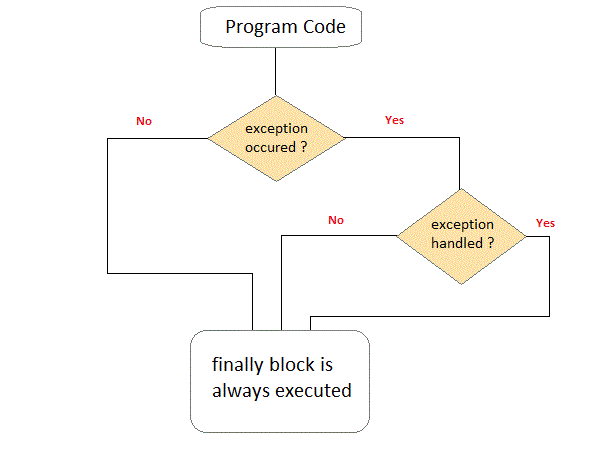Finally Block
1. A finally statement must be associated with a try statement. It identifies a block of statements that needs to be executed regardless of whether or not an exception occurs within the try block.
2. After all other try-catch processing is complete, the code inside the finally block executes. It is not mandatory to include a finally block at all, but if you do, it will run regardless of whether an exception was thrown and handled by the try and catch parts of the block.
3. In normal execution the finally block is executed after try block. When any exception occurs first the catch block is executed and then finally block is executed.
4. An exception in the finally block, exactly behaves like any other exception.
5. The code present in the finally block executes even if the try or catch block contains control transfer statements like return, break or continue.
Syntax of Finally block
try { //statements that may cause an exception } finally { //statements to be executed }
When the finally block doesn’t execute
The circumstances that prevent execution of the code in a finally block are:
– The death of a Thread
– Using of the System. exit() method.
– Due to an exception arising in the finally block.
Finally block and Return statement
Finally block executes even if there is a return statement in try-catch block.
Example :
Example :
class JavaFinally { public static void main(String args[]) { System.out.println(JavaFinally.myMethod()); } public static int myMethod() { try { return 112; } finally { System.out.println("This is Finally block"); System.out.println("Finally block ran even after return statement"); } } }
Output :
This is Finally block Finally block ran even after return statement 112
Finally and Close()
Close() is generally used to close all the open streams in one go. Its a good practice to use close() inside finally block. Since finally block executes even if exception occurs so you can be sure that all input and output streams are closed properly regardless of whether the exception occurs or not.
Example :
.... try{ OutputStream osf = new FileOutputStream( "filename" ); OutputStream osb = new BufferedOutputStream(opf); ObjectOutput op = new ObjectOutputStream(osb); try{ output.writeObject(writableObject); } finally{ op.close(); } } catch(IOException e1){ System.out.println(e1); } ...
Finally block without catch
A try-finally block is possible without catch block. Which means a try block can be used with finally without having a catch block.
... InputStream input = null; try { input = new FileInputStream("inputfile.txt"); } finally { if (input != null) { try { in.close(); }catch (IOException exp) { System.out.println(exp); } } } ...
Finally block and System.exit()
System.exit() statement behaves differently than return statement. Unlike return statement whenever System.exit() gets called in try block then Finally block doesn’t get executed. Refer the below example to understand it better –
.... try { //try block System.out.println("Inside try block"); System.exit(0) } catch (Exception exp) { System.out.println(exp); } finally { System.out.println("Java finally block"); } ....
In the above example if the System.exit(0) gets called without any exception then finally won’t execute. However if any exception occurs while calling System.exit(0) then finally block will be executed.
Handling try-catch-finally block
- Either a try statement should be associated with a catch block or with finally.
- Since catch performs exception handling and finally performs the cleanup, the best approach is to merge both of them.
Syntax:
try { //statements that may cause an exception } catch (…) { //error handling code } finally { //statements to be executed }
Examples of Try catch finally blocks
1.
Below example illustrates finally block when no exception occurs in try block
Below example illustrates finally block when no exception occurs in try block
class Example1{ public static void main(String args[]){ try{ System.out.println("First statement of try block"); int num=45/3; System.out.println(num); } catch(ArrayIndexOutOfBoundsException e){ System.out.println("ArrayIndexOutOfBoundsException"); } finally{ System.out.println("finally block"); } System.out.println("Out of try-catch-finally block"); } }
Output:
finally block Out of try-catch-finally block
Example :
2.
Below example illustrates finally block execution when exception occurs in try block but doesn’t get handled in catch block.
2.
Below example illustrates finally block execution when exception occurs in try block but doesn’t get handled in catch block.
class Example2{ public static void main(String args[]){ try{ System.out.println("First statement of try block"); int num=45/0; System.out.println(num); } catch(ArrayIndexOutOfBoundsException e){ System.out.println("ArrayIndexOutOfBoundsException"); } finally{ System.out.println("finally block"); } System.out.println("Out of try-catch-finally block"); } }
Output:
First statement of try block finally block Exception in thread "main" java.lang.ArithmeticException: / by zero at beginnersbook.com.Example2.main(Details.java:6)
Example :
3.
Below example illustrates execution of finally, when exception occurs in try block and handled in catch block.
3.
Below example illustrates execution of finally, when exception occurs in try block and handled in catch block.
class Example3{ public static void main(String args[]){ try{ System.out.println("First statement of try block"); int num=45/0; System.out.println(num); } catch(ArithmeticException e){ System.out.println("ArithmeticException"); } finally{ System.out.println("finally block"); } System.out.println("Out of try-catch-finally block"); } }
Output:
First statement of try block ArithmeticException finally block Out of try-catch-finally block


Comments
Post a Comment